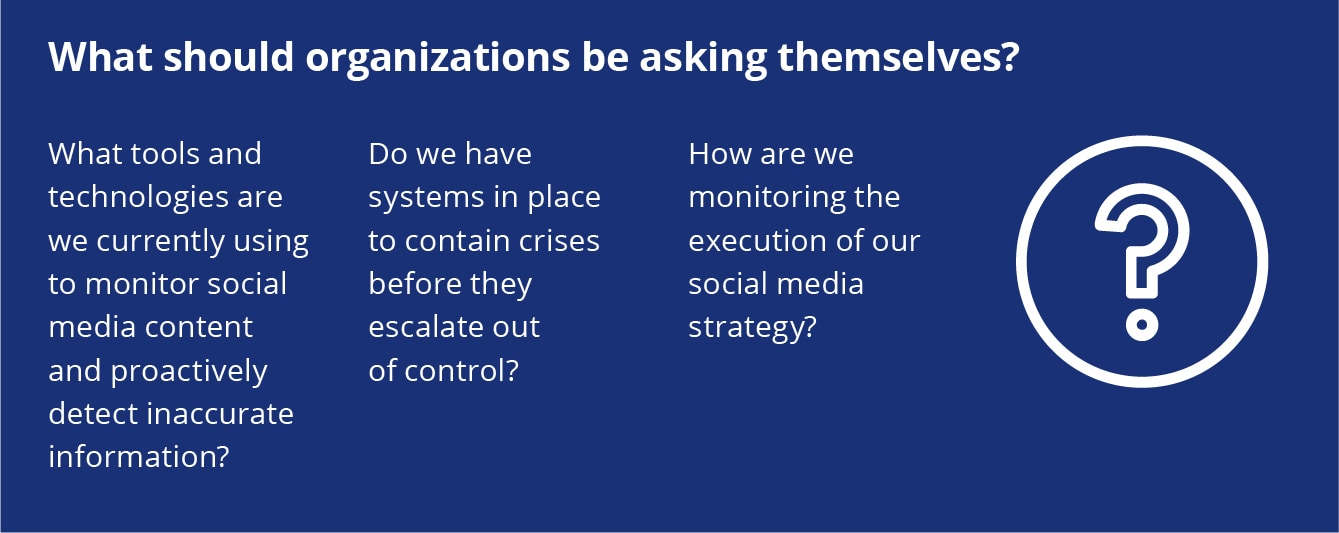Combating weaponized misinformation has been saved

Analysis
Combating weaponized misinformation
Future of risk in the digital era
Large-scale spread of misinformation, enabled by advanced information manipulation tools and online platforms, is driving new types of information warfare.
Explore content
- Why is this trend important today?
- Where has this trend had an impact?
- What does this mean for organizations?
- How can organizations respond?
- What should organizations be asking themselves?
Why is this trend important today?
This article is one of nine trends outlined in Deloitte's Future of risk in the digital era report.
Access to sophisticated tools that employ machine learning, automated software bots, and natural language generation makes it easier for people with limited technical skills to create and spread manipulated information at scale. This manifests in a variety of ways, such as social media bots influencing public opinion, false trends through paid online reviews, fake photos
Nation-states, organized crime groups, companies, and even disgruntled customers have begun using such tools to promote a malicious agenda, gain a competitive advantage, or simply create mischief. What’s alarming is not only how easy it is to start and spread misinformation at scale but also the difficulty in determining its authenticity and stopping it from spreading. In such an environment, organizations need to protect their brand safety and reputation by closely monitoring publicly created content.
Where has this trend had an impact?
- Over the past year, a retail chain has experienced multiple instances of negative false news spreading virally, such as fabricated reports of discrimination, leading to increased public scrutiny and damage to its brand and reputation.
- A company experienced a significant drop in stock price and reduced sales as fake news, which used misquoted interview statements by an executive, began spreading across social media, leading to consumer backlash.
- A new AI-based image synthesis technique, “
deepfake

What does this mean for organizations?
- Brand and reputational damage as false information, created using digital editing and imitation technologies, spreads rapidly to a large audience—inciting unwarranted reactions and delegitimizing leaders and influencers.
- Loss of public trust in organizations due to amplification of manipulated information to create fake trends through false online reviews, biased search engine results, spam emails, and activism.
- Financial losses, such as drops in market capitalization and product sales associated with loss of stakeholder or public trust, due to the rapid spread of misinformation.
- Difficulty identifying the individual or groups responsible for the origin of false news and curbing that disinformation as it spreads quickly across private social media networks.

How can organizations respond?
- Formulate a brand safety and resiliency strategy by identifying potential vulnerabilities and developing an action plan to mitigate risks of the large-scale spread of fake information.
- Augment existing social media strategies to include collaborating with social media platforms to build a strong voice online and flag inaccurate content.
- Proactively develop guidelines to vet public relations firms’ social media strategies to avoid association with vendors that may be using unethical practices to generate positive endorsements.
- Leverage sophisticated social media risk sensing tools that can monitor digital media platforms and data sources, such as proprietary databases and content in different languages, in real time to predict and detect issues before they spiral out of control.
- Develop a crisis response plan that helps stakeholders effectively communicate the difference between perceived and actual reality and reduce the risk of alienating existing and new customers.


Explore all trends in this report









Return to the main report:
Let’s talk
Contact us to discuss how you can better prepare for what’s ahead. We can help you identify ways for your organization to manage risk, create value, and ultimately power your performance.
Recommendations
Deepfakes and AI
Questioning artificial intelligence ethics and the dangers of AI





